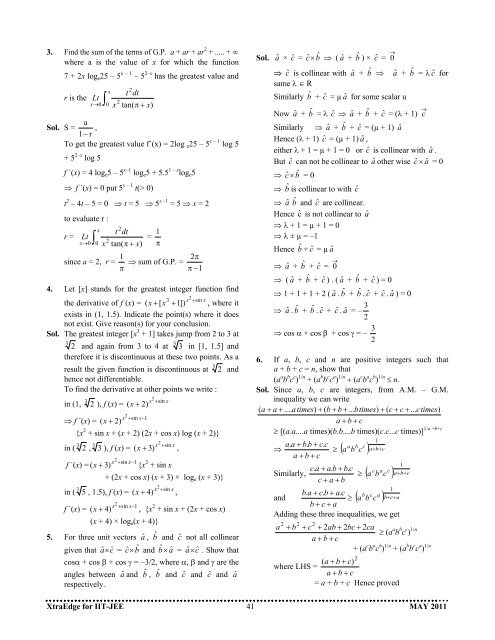May 2011 - Career Point
May 2011 - Career Point
May 2011 - Career Point
- No tags were found...
You also want an ePaper? Increase the reach of your titles
YUMPU automatically turns print PDFs into web optimized ePapers that Google loves.
3. Find the sum of the terms of G.P. a + ar + ar 2 + ..... + ∞where a is the value of x for which the function7 + 2x log e 25 – 5 x – 1 – 5 2–x has the greatest value andx t dtr is the Ltx→∫ 02x tan( π + x20 )aSol. S =1− r,To get the greatest value f´(x) = 2log e 25 – 5 x – 1 log 5+ 5 2–x log 5f ´(x) = 4 log e 5 – 5 x–1 log e 5 + 5.5 1 – x log e 5⇒ f ´(x) = 0 put 5 x – 1 t(> 0)t 2 – 4t – 5 = 0 ⇒ t = 5 ⇒ 5 x –1 = 5 ⇒ x = 2to evaluate r :x 2t dt 1r = Ltx→∫=0 02x tan( π + x)π1 2πsince a = 2, r = ⇒ sum of G.P. = π π −14. Let [x] stands for the greatest integer function find23 x + sin xthe derivative of f (x) = ( x + [ x + 1]) , where itexists in (1, 1.5). Indicate the point(s) where it doesnot exist. Give reason(s) for your conclusion.Sol. The greatest integer [x 3 + 1] takes jump from 2 to 3 at3 2 and again from 3 to 4 at 3 3 in [1, 1.5] andtherefore it is discontinuous at these two points. As aresult the given function is discontinuous at 3 2 andhence not differentiable.To find the derivative at other points we write :in (1, 3 2 ), f (x) = ( x + 2)2x + sin x−12x + sin x⇒ f ´(x) = ( x + 2){x 2 + sin x + (x + 2) (2x + cos x) log (x + 2)}2x + sin xin ( 3 2 , 3 3 ), f (x) = ( x + 3) ,2x + sin x−1f ´(x) = ( x + 3) {x 2 + sin x+ (2x + cos x) (x + 3) × log e (x + 3)}2x + sin xin ( 3 5 , 1.5), f (x) = ( x + 4) ,2x + sin x−1f ´(x) = ( x + 4) , {x 2 + sin x + (2x + cos x)(x + 4) × log e (x + 4)}5. For three unit vectors â , bˆ and ĉ not all collineargiven that aˆ× cˆ= cˆ× bˆand b ˆ× aˆ= aˆ×c ˆ . Show thatcosα + cos β + cos γ = –3/2, where α, β and γ are theangles between â and bˆ , bˆ and ĉ and ĉ and ârespectively.Sol. â × ĉ = cˆ× bˆ⇒ ( â + bˆ ) × ĉ = → 0⇒ ĉ is collinear with â + bˆ ⇒ â + bˆ = λ ĉ forsame λ ∈ RSimilarly bˆ + ĉ = µ â for some scalar uNow â + bˆ = λ ĉ ⇒ â + bˆ + ĉ = (λ + 1) → cSimilarly ⇒ â + bˆ + ĉ = (µ + 1) âHence (λ + 1) ĉ = (µ + 1) â ,either λ + 1 = µ + 1 = 0 or ĉ is collinear with â .But ĉ can not be collinear to â other wise cˆ × aˆ= 0⇒ cˆ × bˆ= 0⇒ bˆ is collinear to with ĉ⇒ â bˆ and ĉ are collinear.Hence ĉ is not collinear to â⇒ λ + 1 = µ + 1 = 0⇒ λ ± µ = –1Hence bˆ + ĉ = µ â⇒ â + bˆ + ĉ = → 0⇒ ( â + bˆ + ĉ ) . ( â + bˆ + ĉ ) = 0⇒ 1 + 1 + 1 + 2 ( â . bˆ + bˆ . ĉ + ĉ . â ) = 03⇒ â . bˆ + bˆ . ĉ + ĉ . â = – 2⇒ cos α + cos β + cos γ = – 236. If a, b, c and n are positive integers such thata + b + c = n, show that(a a b b c c ) 1/n + (a b b c c a ) 1/n + (a c b a c b ) 1/n ≤ n.Sol. Since a, b, c are integers, from A.M. – G.M.inequality we can write( a + a + .... atimes)+ ( b + b + ... btimes)+ ( c + c + ... ctimes)a + b + c1/a +b+c≥ [(a.a....a times)(b.b....b times)(c.c...c times)]1a.a + b.b + c.c a b c⇒≥ ( a b c ) a+b+ca + b + c1c.a + a.b + b.c c a cSimilarly,≥ ( a b c ) a+b+cc + a + b1b.a + c.b + a.c b c aand≥ ( a b c ) b+c+ab + c + aAdding these three inequalities, we get2 2 2a + b + c + 2ab+ 2bc+ 2ca≥ (a a b b c c ) 1/na + b + c+ (a c b a c b ) 1/n + (a b b c c a ) 1/n2( a + b + c)where LHS =a + b + c= a + b + c Hence provedXtraEdge for IIT-JEE 41 MAY <strong>2011</strong>

















